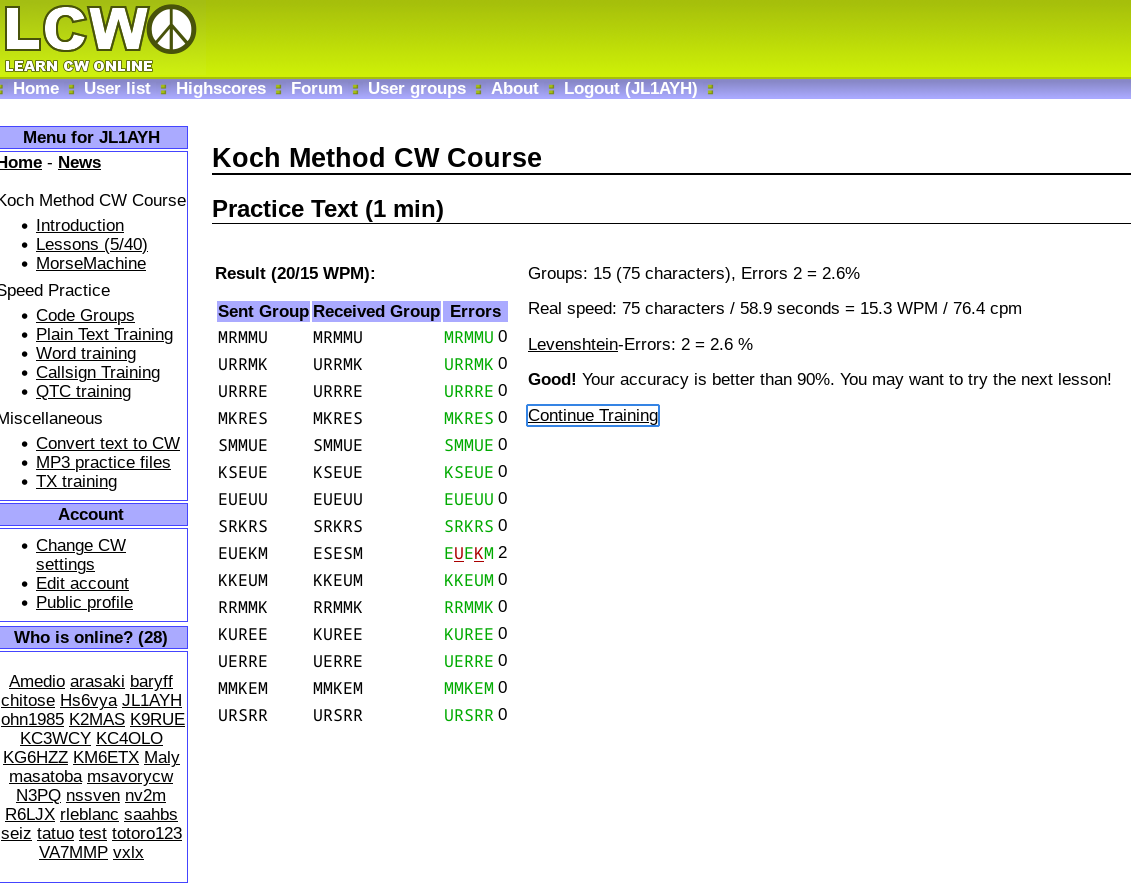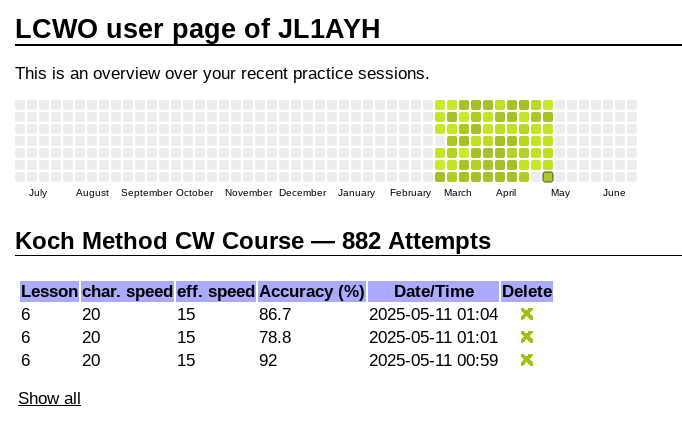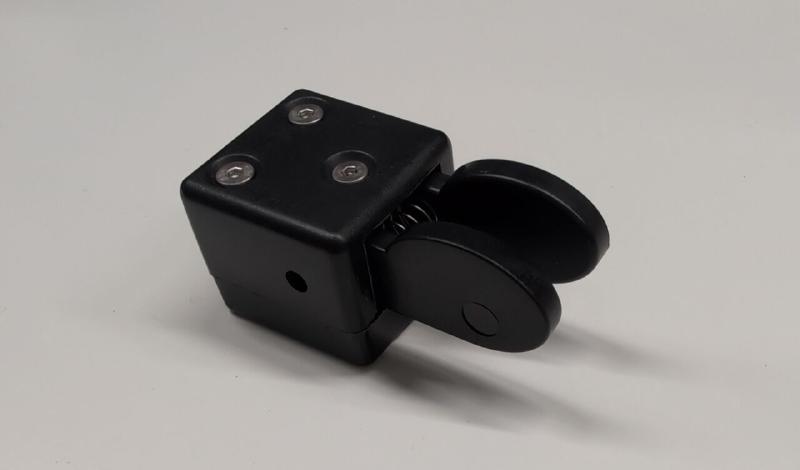What’s Morse Code?
Morse Code, also known as Continuous Wave (CW), is one of the oldest ways of electronic communication. You might also know the term from movies, when in emergency situations someone encodes Morse Code in hitting a pipe with a hammer, and someone else picks this up in listening to the sound transmitted by the pipe.
~40 characters get encoded into sequences of
- short dots, also called “dits”
- and longer dashes, also called “dahs”
For sending out morse code, one has to translate sequences of words/numbers into the matching sequences of dits and dahs. The length of the dahs is defined as “three times the length of a dit”. Also the spaces between the characters and between the words are defined, allowing the other side to pick up the transmission.
The famous SOS gets encoded as “… - - - …” .
Why learn Morse?
70 years ago, the HAM radio exams all over the world required to also pass a CW test, but that’s dropped now mostly. Hundred years ago, CW was the most efficient way to communicate over the air. A simple sound gets either modulated, or not. Short time of modulation is a “dit”, longer modulation a “dah”. Transmitters for CW can be much simpler than transmitters for voice modulation, and with high noise levels, CW is more easy to pick up than voice.
That said, even if CW can be heard more easy than voice (so “is there a signal or not?”), learning it is quite hard. Nowadays, digital modes like FT8 where for example a computer is putting a signal onto the air, are even more efficient than CW. So they get the communication through under conditions when CW is no longer possible.
So why would one want to learn it? Why do people learn music instruments, or paint pictures? To obtain a skill, to have fun, to potentially entertain others. No matter how bad you are at playing an instrument, it might still spark joy in you - then it’s worth doing.
In HAM radio, CW is heavily used. There are contest activities like “Summits On The Air” (SOTA) where HAM’s go to mountains, setup an antenna and a transmitter, and make connections to other stations. Points are awarded based on the number of confirmed connections. CW connections get here more points, the CW transmitters are also smaller, easier to handle. Activities like SOTA are a further argument to learn CW.
So, let’s give it a try.
CW learning
There are 2 parts to CW learning:
- the picking up, also called “to read CW”
- and to send
So far, I tried to learn 4 languages in my life, and use 3 of them daily. I used various methods for learning, so the first step to learn CW was to research “ways to learn”.
One would think: let’s start like children learning the alphabet or Kanji in school: introduce one after the other, have them memorize, have them read and write. This works also for CW, in the same way you can memorize the alphabet or the Korean Hangul after a short time - or after a longer time Kanji.
You can then read or write the letters as dits and dahs, or listen to a very slow Morse Code. The twist: in the real world you need to aim at communication of 20 words per minute, with each word having an average of 5 characters.
The Long Island CW Club is picking up this approach to start slow, and then increase the speed. Yet, as the speed increases, the characters will morph into different sounds - and many think that achieving high speeds is hard with having started slowly.
An often quoted study on learning CW is from Ludwig Koch. Luckily the study is in German, I read it natively - not claiming my conclusions are all correct, of course. LICW has an English summary. Following the results from the Koch study, one would right from the start learn with 20 words per minute: first one gets introduced to the Morse expressions of 2 characters. Then one gets for 60 seconds sequences of these 2 characters, the goal is to pick them up correctly and note them down. Learn CW online uses the method, I started on the page. You can write down the characters on paper and later fill them into the website text field, or directly write into the website - that’s what I do. After listening the Morse Code for ~60 seconds, and writing the sequences you think you picked up, you click “check” and then see how well you picked up the code. If you feel unsure, you can also listen to the same ~60 seconds sequence multiple times, and make corrections to the characters you noted down. The goal is to pick up 90% or more of the characters correctly after listening to the sequence just a single time. When that’s accomplished, a further character is added.
Sounds hard? It is! People with a talent for music seem to do better, pick up things easier. Now after 2.5 months I’m doing the lesson with 7 different characters. 40 in total…
Side quest: speed typing
Starting learning with the Koch method, I did run into a further issue: so far I was reasonably fast with 2-finger-typing. But already when learning the 4th character with the Koch method, I entered the side quest of learning 10 finger typing.
That’s actually going quite well after 2 weeks of training on typingstudy.

More thoughts
One interesting point: the sequences on Learn CW online are just random, not actual words. With 7 characters, you can build already some actual words. But then: would it make more sense to learn with words? When reading English or German, after a while you start to recognize all the letters of a word all together, instead of letter-by-letter. Same in Japanese. Also with CW, it is said that one builds up recognition of full words after some time. Needs much exposure to CW, of course. Typical CW communication includes to say the call name of the HAM radio operator, you get fluent to read/write that quickly. But then, reading the call name of the other partner of the communication will look much like random characters, not something like a word. So maybe training with random sequences is not that bad after all.
For motivation, the Long Island method might make sense: you can right from start get into online-video sessions with others on your speed level and learn together. Just the “speeding up” might be harder than directly starting with high speed.
Will it be easier to learn CW in just listening to it, in the background? I think no. In the morning I’m following Japanese news tv online, mostly listening while catching up with the Mastodon time line. One hears every now and then important words, and then I switch to the browser-tab with the news site and actually follow the news. But one needs to really concentrate to understand, I’m not convinced that just listening passively is helping.
Fixing habits
After 3 months, I got aware of a bad learning behaviour and needed to fix that: usually one listens to ~1min of CW characters, tries to pick them up, and type the characters into a text field. One has 2 options then:
- To listen again, and make corrections over what was heard and typed in with the first run.
- Or directly click “check result” and get rated.
I had gotten into the habit of listening 2 or 3 times, and just then “check result”. After asking in the forum on whether that could also be shown in the stats, I got aware that this is not intended. So since then, in almost all cases I directly check the result.
Let’s see how far I get, if I can at some point go to a mountain and do SOTA with Morse Code. :)

Hints, comments, own experiences welcome! -> Fediverse thread
